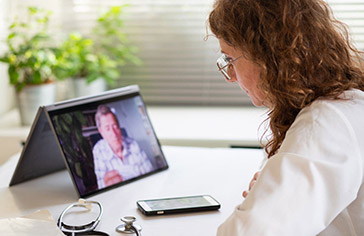As the ability to access critically important needs at a distance increases—groceries, medicine, learning and work—so does the demand for medical access. Whether your patients need you urgently or they have an ongoing condition that needs constant monitoring, telehealth gives you and them access to improved communication and care. For patients who are recovering from an injury or who are coping with a disabling condition, the ability to engage in rehab and occupational medicine can be a lifeline to better confidence and personal care skills.
Traditionally, occupational medicine is done in a facility but with the proper equipment and instruction at your patients’ disposal, they can be coached through their treatment plan at a distance via telehealth visits. Whether due to the pandemic or the myriad of other reasons a person might not want to travel for a visit, telehealth can improve access for your occupational health patients. Let’s examine some ways you can use virtual visits and a telehealth platform to create an effective occupational health practice remotely.
Why Would a Patient Choose Occupational Telehealth?
There are many reasons for choosing telehealth over in-office visits, but the primary ones are based on accessibility. For a patient with chronic pain or mobility issues, getting into a vehicle to travel even a moderate distance can be painful, difficult, inconvenient, or stressful. Additionally, waiting for your visit in a doctor’s office can be dramatically more unpleasant than waiting at home if the previous appointment runs long or your physician is running late.
In-office visits can also be booked up significantly in advance. Remote access allows more patients to be connected with their primary treating physicians, ensuring your patients are able to get to their appointments and stay on schedule with their treatments. Finally, maintaining a large occ-med center can be expensive, especially when lockdowns are currently preventing many indoor businesses from meeting as normal. Telehealth can help you cut down on expenses especially if you cannot use or maximize the use of your facility.
Make a plan about your expectations
Why are you setting up occupational therapy telehealth service? Are you trying to reach new customers, improve reach for your existing patients, or is there a lack of similar services in your area? Each of these situations requires different marketing and strategies and having a partner that is well-versed in the telehealth field to help you shore up your targeted advertising. More than anything, improving access to care for rural communities and for those who have limited mobility is the biggest reason they want to expand to occupational therapy in telehealth, and even in those cases, you need to be able to spread the word about your services.
Therapy for Chronic Care Conditions
For those who require constant monitoring and progressive therapy, being able to ensure they don’t miss an appointment is a huge benefit of telehealth. Many times those who have disabling conditions simply cannot make appointments for one reason or another, and virtual visits are a great way to ensure better attendance. Additionally, many patients face socio economic hurdles like transportation access, so virtual visits can help alleviate that burden and make them less likely to miss an appointment.
Focus on How You Can Help Your Patients at a Distance
Both in advertising your practice to a broader audience and in selling the idea of virtual visits to your current client base, you need to ensure that the benefits of remote therapy are clear. Be clear about the fact that you can still continue therapy effectively at a distance, the benefits of continuous, uninterrupted therapy sessions, and how your patients can improve over time by coming to virtual sessions.
Create an At-Home Protocol
Ensure that your patients understand what devices they may need to continue their therapy at home, and use your telehealth platform to connect with medical supply providers to get them what they need at the lowest possible cost. It’s also worth investing some time in finding some around-the-home alternatives they can work with during therapy, if possible. With remote sessions, it’s a great time to create a homework plan that enables them to continue to work on their activities of daily living skills.
People learn better when they practice in a similar setting to where they learn and there is no better time than now to incorporate home learning with home practice. By encouraging and outlining the methods of at-home therapy, you will generally see better improvement and compliance in your patients. This leads to better mastery of the skills they need, overall increased quality of life and confidence, and getting them back to work as rapidly as possible.
Ensure Data Confidence
Between patient intake, referrals, and supply requisition, a lot of patient data will move around remotely in a telehealth practice. You need top-notch cybersecurity systems in place, but you need to ensure that your platform is one that takes data security seriously. ViTel is proud of our advanced, ultra-secure data storage processes, as well as our encryption processes that ensure the utmost in patient data security.
Whether you’re referring your patient to a specialist, requesting medical supplies, billing or doing intake, ViTel’s platform will protect you and your patients from unwanted, unlawful data breaches. You can treat your patients confidently and they can engage in the process without worrying if their sensitive data is secure.
Constant Updates
By engaging with your patients remotely, you can see in real-time their improvements and where they need additional help. With ViTel’s state of the art workers’ compensation telehealth platform your patients and their physical therapists can report on their progress or deficits so you can create a custom, up-to-date treatment plan. Imagine if you had to have them come into a physical office multiple times a week or month to update you on their progress, but telehealth makes it simple and efficient.
Virtual Therapy Visits are the Future
As more and more care facilities offer virtual visits, state governments are following suit to make sure physicians receive proper compensation. Many states are mandating that fully-insured private plans cover and reimburse for telemedicine services equally to how they would for in-person care. This means you’ll be receiving the same compensation for services whether they are delivered over telehealth or in-person.
This is important as all manner of physician care facilities are moving to offer remote patient access—occupational medicine among them. There’s no reason to not engage your patients in a virtual way to ensure an improved treatment plan and a return to work plan. ViTel’s telehealth platform provides the integration, connections with specialists, ancillary services, and other medical professionals that are necessary to run a successful telehealth practice. ViTel helps grow your business by driving new patients to your practice as well.
Discover the Recupe app and how it can augment in-person therapy with at-home monitoring.







